Rooftop fish and chip shop by Something & Son is (slowly) growing its own produce
Design duo Something & Son has created a sustainable farming initiative on a rooftop in Folkestone, England, but has concealed it behind a traditional fish and chip shop facade (+ slideshow + interview).
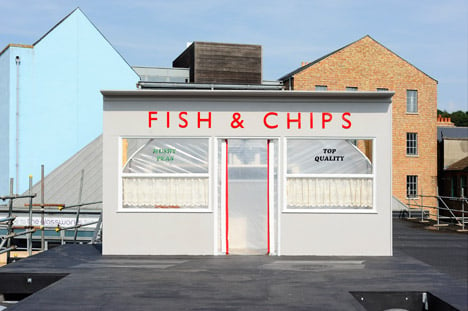
Built as part of the Folkestone Triennial, the Amusefood installation comprises a simple polytunnel, inside which the designers have created a facility for farming fish, potato plants and pea shoots.
"We started with the idea of the fish and chips of the future," explained Paul Smyth, who alongside fellow designer Andrew Merritt co-founded Something & Son, a studio known for its work in urban agriculture.
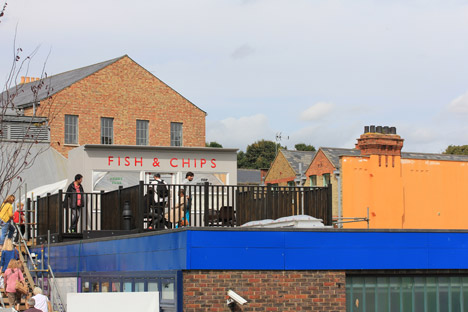
"We used a polytunnel to explore the way that food can be grown in the future when fish stocks are depleted and when food is more expensive, how a local community can start to grow its food in a very intensive and technological way," he told Dezeen.
The experimental greenhouse is fronted by a traditional shop facade, designed to lure visitors up onto the rooftop and encourage them to venture inside.
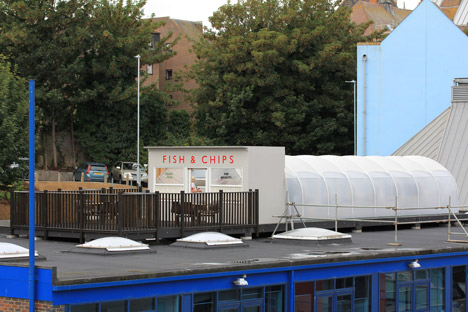
"People are used to being confronted with a bog-standard fish and chip shop facade and they've got a relationship with that, but this is something that they don't really know or understand," said Merritt. "We were trying to help introduce people to this new technology and this new type of thinking."
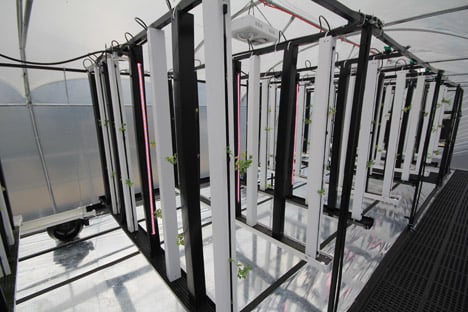
Over the two-month duration of the triennial the designers hope to have grown enough produce for one portion of fish and chips, but are keen for the structure to stay in place and grow over time, under the control of the local community.
"When people came down to the opening they were like, 'Where's all the fish?' and 'Where's all the chips?' It's that kind of culture of expecting things there and then," said Smyth.
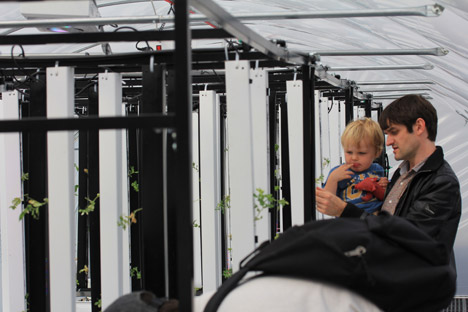
"This project is starting from the ground up, so all the fish are small and all the plants are small. We're using the time of the triennial to grow everything, so people can come back and see the project develop," he added.
A series of automated systems have been added to regulate the facility, including self-adjusting lighting systems and water monitoring.
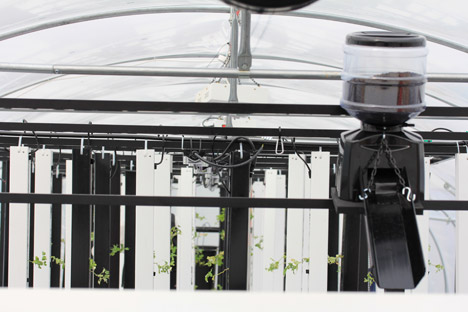
At night, lights inside the facility transform it into a glowing beacon on the skyline. According to the designers, this creates a reference to the amusement arcades that were once popular in the seaside town, prompting the name Amusefood.
"People can look into this strange greenhouse throbbing away in the evening, but it actually has a function too," said Smyth.
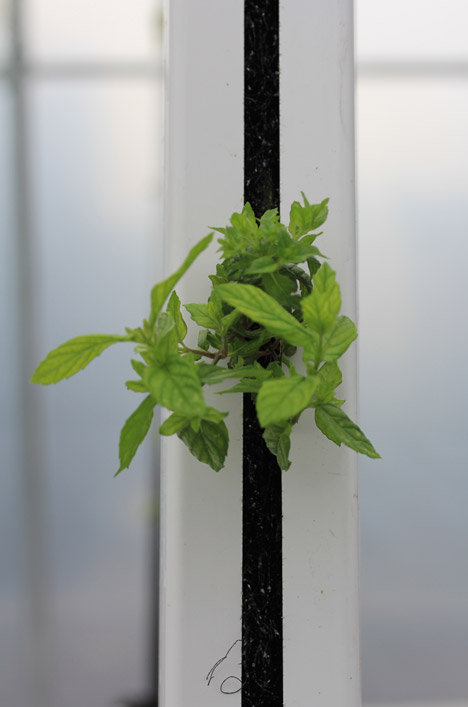
The Folkestone Triennial continues until 2 November. Other installations created for the event include headless chickens that respond to internet panic and a combined lighthouse and beach hut inspired by 18th century architect Nicholas Hawksmoor.
Read the full interview with Something & Son:
Amy Frearson: Tell me about the project.
Andrew Merritt: The project started off on a roof, and we wanted to engrain it into the idea of the south coasts and seaside towns so we based it around fish and chips – the future of fish and chips but also bringing in the amusement arcades as well. Folkestone used to have a large arcade on the seafront that was knocked down within the last ten years, so we wanted to rethink how the seaside town can attract people back down in the 21st century. Folkestone obviously used to be a really big attraction to the Victorians and we wanted to try and revive that.
Amy Frearson: And what have you created?
Paul Smyth: We started with the idea of the fish and chips of the future. So we used a polytunnel to explore the way that food can be grown in the future when fish stocks are depleted and when food is more expensive, how a local community can start to grow its food in a very intensive and technological way.
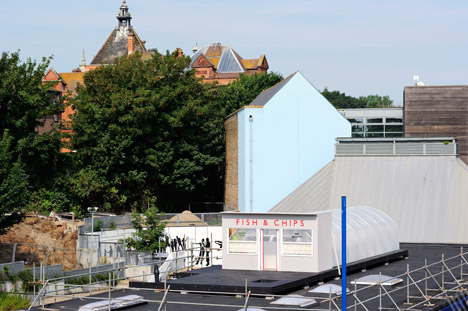
Andrew Merritt: We built a green-house that is capable of growing maybe a hundred fish and maybe £4000 worth of food crops. It's a big experiment so in the next few months we're only going to get one of those growing – one portion of fish and chips – then kind of go from there.
Paul Smyth: When people came down to the opening they were like, "Where's all the fish?" and "Where's all the chips?" It's that kind of culture of expecting things there and then. This project is starting from the ground up, so all the fish are small and all the plants are small. We're using the time of the triennial to grow everything, so people can come back and see the project develop.
Amy Frearson: What kinds of fish are you farming?
Paul Smyth: At the moment we're growing carp and tilapia, which are fish that are very easy to farm. They are quite new to the UK but in other parts of the world they are very popular. You could argue that they're the future of farming because they are quite easy to farm, so people are using them a lot.
Amy Frearson: What role do you play in the project and how is the farm managed?
Andrew Merritt: During the project we build the team, the people who then will bring the project on after we leave.
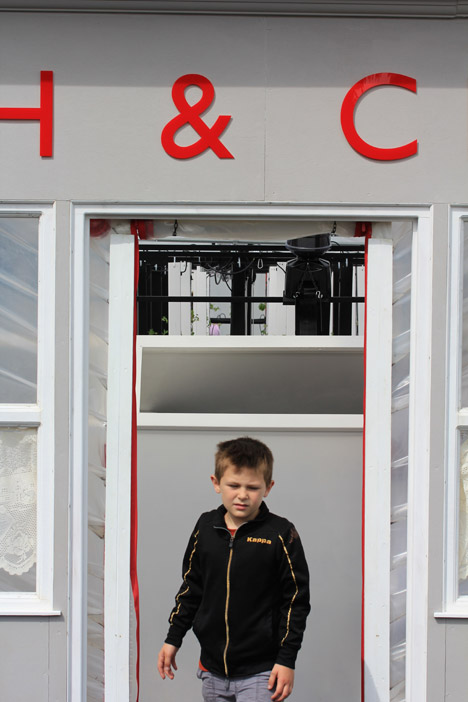
Paul Smyth: Also with this one we've got quite a lot of automation, because I guess in the future this type of farm will need to be heavily automated. There are things that we've done which means that we're not putting too much burden on the people who first start using it. And it's almost like we're looking for part-time farmers who can keep the crops growing. For example, on our Facebook page we published a list of tasks for a couple of people who are based down at the school.
Andrew Merritt: And we've built in a load of automated sensors so, for instance, the lights go up and down depending on sunlight level, and also in the water there are a load of sensors that will measure levels of nitrate and oxygen. These kinds of systems will help the people who will be looking after it over the next couple of months and hopefully years.
Amy Frearson: So is it your plan for the project to continue beyond the duration of triennial?
Paul Smyth: Absolutely, hopefully it will sew the seed of the idea in people's minds, whether they choose to copy or replicate it, but more importantly we'd like this site to stay. If people think it works, and it is working, let's keep it there and we use it as a model for renewal. Although we set it motion we never have complete control over it – the more people who get behind the idea and go along to the site, the more energy there will be to carry on. That's often the case with our projects.
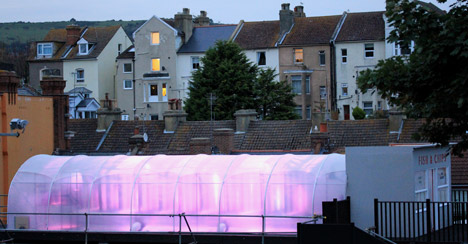
Amy Frearson: Why did you decide to create a shopfront for the building's facade?
Andrew Merritt: That was just about trying to produce something that's both quite foreign to people and also very familiar. People are used to being confronted with a bog-standard fish and chip shop facade and they've got a relationship with that, but this is something that they don't really know or understand. We were trying to help introduce people to this new technology and this new type of thinking.
And also we just like the idea. Because it's on a roof, we were quite interested in setting up quite a surreal situation where you just see, from afar, this little fish and chip shop with a large polytunnel bum coming out from the back.
Amy Frearson: How does the project reference the amusement arcades you mentioned earlier?
Paul Smyth: The polytunnel enabled us to create – at night – this kind of glowing pulsating structure. People can look into this strange greenhouse throbbing away in the evening, but it actually has a function too – it's helping to support the food in a very small space.